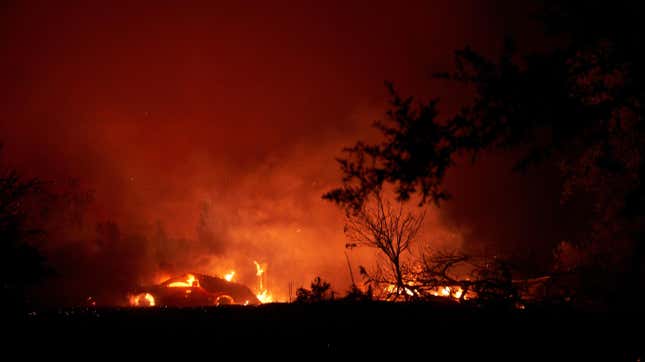
PG&E, the utility that supplies power to 16 million people in northern and central California, is under investigation for starting a deadly fire. Again.
The blaze in question is the Zogg Fire, which has killed four people and destroyed some 200 structures in Northern California. The wildfire broke out on Sept. 27 during strong Diablo winds, dry air, and triple-digit temperatures. Since then, it’s scorched 56,338 acres, and is still burning.
In a Friday filing, PG&E announced that as part of an investigation into how the fire began, Cal Fire, the state’s firefighting agency, took possession of some of the utility’s equipment near where the Zogg Fire started in Shasta County.
Though climate-crisis-fueled hot, dry, windy and conditions make California forests far more flammable, electrical infrastructure like downed power lines can provide the spark to light them up. To mitigate this risk, utilities have increasingly turned to de-energizing transmission lines in areas experiencing high fire risk. In the last week of September, PG&E cut power to tens of thousands of residents, but that didn’t include equipment in south Shasta County area where the Zogg Fire ignited.
If this sounds familiar, it’s because it’s happened before. Fallen PG&E wires caused at least 1,500 fires over the course of six years, including several deadly ones. There was the 2015 Butte Fire in Amador County, which was sparked when a power line hit a tree killed two people. There were the 2017 fires in Wine Country, when PG&E equipment was implicated in multiple fatal blazes. Perhaps most infamously, there was the deadly Camp Fire of 2018, which decimated the town of Paradise and killed 85 people, making it the deadliest corporate crime in history. PG&E declared bankruptcy after the fire as it faced down billions in damages. In total, eight of California’s 20 most destructive wildfires were ignited by electrical infrastructure. (Of the 12 remaining fires, four are still under investigation and could add to the total lit by power lines.)
There are ways the utility could fireproof its grid, including burying power lines and using more locally-controlled energy hubs and battery storage. But so far, PG&E hasn’t done a great job of making necessary changes. In 2018, journalists with local station KTVU found that PG&E used funds set aside for fireproofing its grid for other purposes, including corporate bonuses. In July, California Gov. Gavin Newsom signed a bill allowing California to bring the company under public control if it doesn’t get its act together.
This year’s relentless, record-breaking fire season makes it clear that the changes to how the electric grid functions are more urgent than ever. This week, California will once again face fire weather, so more blazes could be on the way. As a precaution, PG&E has announced that it may have to shut off power for up to three days. But blackouts are inconvenient and can even be dangerous, as they can limit people’s access to food, medical equipment, and technology needed to obtain fire updates. It’s clear that bigger shifts are needed.